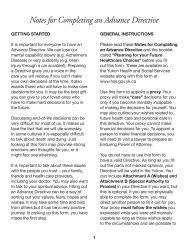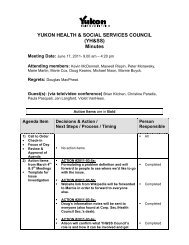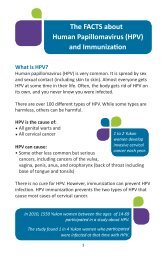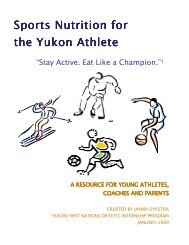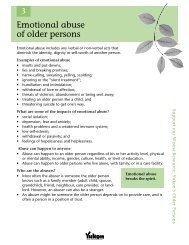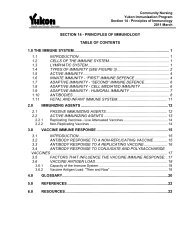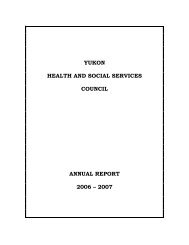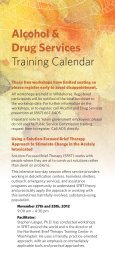Eat Well for Less - Health and Social Services - Government of Yukon
Eat Well for Less - Health and Social Services - Government of Yukon
Eat Well for Less - Health and Social Services - Government of Yukon
You also want an ePaper? Increase the reach of your titles
YUMPU automatically turns print PDFs into web optimized ePapers that Google loves.
Who is this booklet <strong>for</strong>?<br />
This booklet is <strong>for</strong> anyone who would like to spend less money <strong>and</strong> eat<br />
healthy foods. <strong>Health</strong>y eating is important <strong>for</strong> all age groups. What you eat<br />
can affect your health, energy level <strong>and</strong> the way you feel about yourself.<br />
This booklet will help you save money on food by providing tips <strong>and</strong> suggestions<br />
while following Canada’s Food Guide.<br />
Table <strong>of</strong> Contents<br />
1. What is <strong>Health</strong>y <strong>Eat</strong>ing? 2<br />
2. <strong>Eat</strong>ing <strong>Well</strong> with Canada’s Food Guide — Food Group Basics 3<br />
3. Menu Planning <strong>and</strong> Food Budgeting 15<br />
4. Sample One Week Menu 16<br />
5. Basic Food to Have on H<strong>and</strong> 18<br />
6. Smart Shopping Tips 19<br />
7. Storing Your Food 20<br />
8. Recipes 21<br />
9. Emergency Food Resources 30<br />
10. Acknowledgements 30<br />
11. Notes 31<br />
1
1. What is <strong>Health</strong>y <strong>Eat</strong>ing?<br />
<strong>Eat</strong>ing is one <strong>of</strong> the best things life has to <strong>of</strong>fer. Food helps you celebrate with your<br />
family <strong>and</strong> friends. It nourishes your body. It gives you energy to get through<br />
each day. The right balance <strong>of</strong> food <strong>and</strong> activity helps you to prevent disease <strong>and</strong><br />
maintain a healthy body weight. <strong>Eat</strong>ing <strong>Well</strong> with Canada’s Food Guide is a tool to<br />
help Canadians over the age <strong>of</strong> two make healthy food choices.<br />
Each <strong>of</strong> the food groups listed in Canada’s Food Guide is important because it provides its<br />
own set <strong>of</strong> nutrients. No food or meal is “good” or “bad.” <strong>Health</strong>y eating means having<br />
a variety <strong>of</strong> foods from each food group every day in moderate amounts.<br />
2
2. <strong>Eat</strong>ing <strong>Well</strong> with Canada’s Food<br />
Guide—Food Group Basics<br />
You need to eat foods from each <strong>of</strong><br />
the four food groups in <strong>Eat</strong>ing <strong>Well</strong><br />
with Canada’s Food Guide every<br />
day. The number <strong>of</strong> servings you need to<br />
eat from each food group depends on your<br />
age <strong>and</strong> how active you are.<br />
Let’s look at the food guide <strong>and</strong> money<br />
saving ideas when shopping <strong>for</strong> <strong>and</strong><br />
preparing food.<br />
Vegetables<br />
<strong>and</strong> Fruit<br />
Grain<br />
Products<br />
Milk <strong>and</strong><br />
Alternatives<br />
Meat <strong>and</strong><br />
Alternatives<br />
3
Vegetables <strong>and</strong> Fruit<br />
Why do you need them?<br />
Vegetables <strong>and</strong> fruit have important nutrients such as vitamins, minerals <strong>and</strong><br />
fibre. They are also usually low in fat <strong>and</strong> calories <strong>and</strong> may help prevent heart<br />
disease <strong>and</strong> some types <strong>of</strong> cancer.<br />
How much do you need?<br />
Number <strong>of</strong> Food Guide<br />
Servings <strong>of</strong> Vegetables<br />
Age<br />
<strong>and</strong> Fruit per day<br />
Toddlers 2–3 years 4<br />
Children 4–8 years 5<br />
Youth 9–13 years 6<br />
Teens (female) 14–18 years 7<br />
Teens (males) 14–18 years 8<br />
Adults (females) 19–50 years 7–8<br />
Adults (males) 19–50 years 8–10<br />
Adults (females) 51 years <strong>and</strong> older 7<br />
Adults (males) 51 years <strong>and</strong> older 7<br />
Examples <strong>of</strong> 1 serving:<br />
1 medium fruit or vegetable (about the size <strong>of</strong> a tennis ball)<br />
½ cup or 125 mL fresh, frozen or canned vegetables<br />
½ cup or 125 mL juice<br />
1 cup or 250 mL salad<br />
½ cup locally picked berries<br />
4
Vegetables <strong>and</strong> Fruit<br />
Try to:<br />
• <strong>Eat</strong> at least one dark green <strong>and</strong> one orange<br />
vegetable each day (such as broccoli,<br />
spinach, romaine lettuce, carrots <strong>and</strong> squash)<br />
• Choose vegetables <strong>and</strong> fruit prepared with<br />
little or no added fat, sugar or salt<br />
• Have vegetables <strong>and</strong> fruit more <strong>of</strong>ten<br />
than juice<br />
To save money:<br />
• Buy fresh fruits <strong>and</strong> vegetables when they are in season. You can<br />
freeze them too. During the winter, frozen or canned vegetables<br />
or fruit may be the best buy. They are just as nutritious as the<br />
fresh ones.<br />
• Choose frozen vegetables in bags <strong>and</strong> cook only as much as<br />
you need.<br />
• Add leftover vegetables to soups, salads or casseroles. See section<br />
8 <strong>for</strong> recipe ideas.<br />
• Try growing your own vegetables such as potatoes, carrots or beets.<br />
5
Grain Products<br />
Why do you need them?<br />
Grain products, especially whole grains, are a source <strong>of</strong> fibre <strong>and</strong> usually low<br />
in fat. Fibre rich foods can help you feel full <strong>and</strong> whole grains may also help to<br />
prevent heart disease.<br />
How much do you need?<br />
Number <strong>of</strong> Food Guide<br />
Servings <strong>of</strong> Grain Products<br />
Age<br />
per day<br />
Toddlers 2–3 years 3<br />
Children 4–8 years 4<br />
Youth 9–13 years 6<br />
Teens (female) 14–18 years 6<br />
Teens (males) 14–18 years 7<br />
Adults (females) 19–50 years 6–7<br />
Adults (males) 19–50 years 8<br />
Adults (females) 51 years <strong>and</strong> older 6<br />
Adults (males) 51 years <strong>and</strong> older 7<br />
Examples <strong>of</strong> 1 serving:<br />
1 slice <strong>of</strong> bread<br />
35 grams <strong>of</strong> bannock (approx. 2" x 2" x 1")<br />
½ <strong>of</strong> a pita or tortilla<br />
½ cup or 125 mL cooked rice, noodles, spaghetti or macaroni<br />
¾ cup or 175 mL hot cereal or 30 grams <strong>of</strong> cold cereal<br />
6
Grain Products<br />
Try to:<br />
• Make at least half <strong>of</strong> the grain<br />
products you eat every day whole<br />
grain choices<br />
• Choose grain products that are<br />
lower in fat, sugar or salt<br />
To save money:<br />
• Serve cooked cereal <strong>for</strong> breakfast instead <strong>of</strong> cold cereal. Hot cereals<br />
like porridge are a good buy. Instant hot cereals in single serving<br />
packages are convenient, but usually expensive.<br />
• Buy day old bread. Use it right away or store it in the freezer <strong>for</strong> up<br />
to 1 month.<br />
• Cook with noodles, pasta <strong>and</strong> rice. They are nutritious, delicious <strong>and</strong><br />
economical foods.<br />
• Try baking your own muffins (see section 8 <strong>for</strong> recipe ideas). They<br />
cost less, are much lower in fat than store bought ones <strong>and</strong> taste<br />
better too!<br />
7
Milk <strong>and</strong> Alternatives<br />
Why do you need them?<br />
The Milk <strong>and</strong> Alternatives food group provides important vitamins (like Vitamin<br />
D) <strong>and</strong> important minerals (like calcium <strong>and</strong> magnesium) which are important<br />
<strong>for</strong> developing strong bones <strong>and</strong> decreasing the risk <strong>of</strong> osteoporosis.<br />
How much do you need?<br />
Number <strong>of</strong> Food Guide<br />
Servings <strong>of</strong> Milk <strong>and</strong><br />
Age<br />
Alternatives per day<br />
Toddlers 2–3 years 2<br />
Children 4–8 years 2<br />
Youth 9–13 years 3–4<br />
Teens 14–18 years 3–4<br />
Adults 19–50 years 2<br />
Adults 51 years <strong>and</strong> older 3<br />
Examples <strong>of</strong> 1 serving:<br />
1 cup or 250 mL <strong>of</strong> milk<br />
1 cup or 250 mL <strong>of</strong> soy beverage <strong>for</strong>tified with calcium <strong>and</strong> Vitamin D<br />
¾ cup or 175 grams <strong>of</strong> yogurt<br />
1 ½ ounces or 2 slices <strong>of</strong> cheese<br />
8
Milk <strong>and</strong> Alternatives<br />
Try to:<br />
• Drink 2 cups (500 mL) <strong>of</strong> skim,<br />
1% or 2% milk every day<br />
• Drink 2 cups (500 mL) <strong>of</strong> soy<br />
beverage <strong>for</strong>tified with calcium<br />
<strong>and</strong> Vitamin D every day if you<br />
don’t drink milk<br />
• Select lower fat milk alternatives<br />
like cheese <strong>and</strong> yogurt<br />
To save money:<br />
• Make milk from skim milk powder <strong>and</strong> use it <strong>for</strong> cooking or baking.<br />
Mix it with an equal amount <strong>of</strong> skim, 1% or 2% milk <strong>for</strong> drinking.<br />
• Buy cheese in blocks <strong>and</strong> slice or grate it yourself. Sliced cheese<br />
may be cheaper at the deli counter than in packages.<br />
• Freeze grated cheese <strong>and</strong> use it <strong>for</strong> baking or casseroles<br />
• Try making your own milk pudding. See section 8 <strong>for</strong> recipe ideas.<br />
9
Meat <strong>and</strong> Alternatives<br />
Why do you need them?<br />
Foods from the Meat <strong>and</strong> Alternatives food group provide important nutrients<br />
such as iron, magnesium, B Vitamins <strong>and</strong> protein.<br />
How much do you need?<br />
Number <strong>of</strong> Servings <strong>of</strong><br />
Meat <strong>and</strong> Alternatives<br />
Age<br />
per day<br />
Toddlers 2–3 years 1<br />
Children 4–8 years 1<br />
Youth 9–13 years 1–2<br />
Teens (female) 14–18 years 2<br />
Teens (males) 14–18 years 3<br />
Adults (females) 19 <strong>and</strong> older 2<br />
Adults (males) 19 <strong>and</strong> older 3<br />
Examples <strong>of</strong> 1 serving:<br />
75 grams (2 1/2 ounces) or ½ cup (125 mL) <strong>of</strong> cooked meat, (such as moose,<br />
caribou, beef or pork), chicken or fish (a piece just smaller than the size <strong>of</strong> a<br />
deck <strong>of</strong> playing cards)<br />
¾ cup or 175 mL <strong>of</strong> cooked beans, split peas or lentils<br />
2 eggs<br />
2 tablespoons or 30 mL <strong>of</strong> peanut butter<br />
¾ cup (175 mL) or 150 grams <strong>of</strong> t<strong>of</strong>u<br />
10
Meat <strong>and</strong> Alternatives<br />
Try to:<br />
• Choose meat alternatives such as<br />
beans, lentils <strong>and</strong> t<strong>of</strong>u more <strong>of</strong>ten—<br />
they are nutritious, tasty <strong>and</strong> not<br />
too expensive.<br />
• <strong>Eat</strong> at least two ½ cup or 125 mL<br />
servings <strong>of</strong> fish each week.<br />
• Choose lean meat <strong>and</strong> alternatives<br />
prepared with little or no added fat<br />
or salt.<br />
To save money:<br />
• Buy less expensive cuts <strong>of</strong> meat like shoulder, blade <strong>and</strong> stewing<br />
meat. They will be tender if you cook them slowly <strong>for</strong> several hours in<br />
a liquid such as water, soup broth or tomato juice.<br />
• Choose regular or medium ground beef. Just brown it <strong>and</strong> then drain<br />
well to get rid <strong>of</strong> the extra fat.<br />
• Buy a whole chicken or large piece <strong>of</strong> meat <strong>and</strong> cut it into smaller<br />
pieces yourself.<br />
• Shop <strong>for</strong> s<strong>and</strong>wich meat like turkey or roast beef at the grocery store<br />
deli (if available). It usually costs less than buying it in a package.<br />
• Check flyers <strong>and</strong> stock up on canned tuna or salmon when it<br />
is on sale.<br />
• Use leftover meat or chicken bones to make soup.<br />
• Make a stir fry or casserole that uses a small amount <strong>of</strong> meat <strong>and</strong><br />
add lots <strong>of</strong> vegetables, noodles or rice.<br />
• Add beans, chickpeas or lentils to soups, casseroles or salads.<br />
• Try eating a few meatless meals each week such as: bean <strong>and</strong> rice<br />
casserole, cheese omelette, t<strong>of</strong>u <strong>and</strong> vegetable stir fry or vegetarian<br />
chili. See section 8 <strong>for</strong> recipe ideas.<br />
11
Oils <strong>and</strong> Fats<br />
Why do you need them?<br />
Too much fat is not good <strong>for</strong> your health.<br />
However, a small amount <strong>of</strong> the right type<br />
<strong>of</strong> oils <strong>and</strong> fats are important because<br />
they help your body to absorb vitamins<br />
like Vitamins A, D, E <strong>and</strong> K. The type<br />
<strong>of</strong> fat you eat is as important as the<br />
total amount that you eat.<br />
Try to:<br />
• Choose low fat choices from each<br />
<strong>of</strong> the food groups.<br />
• Include a small amount 30–45 mL (2 to 3<br />
tablespoons) <strong>of</strong> unsaturated fat in your foods each<br />
day. This includes margarine, oil used <strong>for</strong> cooking,<br />
salad dressings <strong>and</strong> mayonnaise.<br />
• Choose tub margarine that is low in saturated <strong>and</strong><br />
trans fat. Read the label <strong>and</strong> look <strong>for</strong> margarine that<br />
has 5% or less daily value from saturated <strong>and</strong><br />
trans fat.<br />
• Use vegetable oils such as canola, olive <strong>and</strong><br />
soy bean.<br />
• Limit the amount <strong>of</strong> butter, hard margarine, lard <strong>and</strong> shortening<br />
you eat.<br />
To save money:<br />
Try making your own salad dressing by mixing together some<br />
ingredients you always have on h<strong>and</strong>. It’s healthier <strong>and</strong> less<br />
expensive. See section 8 <strong>for</strong> recipe ideas.<br />
12
Beverages<br />
In addition to drinking two glasses <strong>of</strong> low fat milk<br />
every day, water is a great way to quench your<br />
thirst <strong>and</strong> keep you hydrated. You need more<br />
water in hot weather or when you are very active.<br />
Try to:<br />
• Limit beverages that are high in calories, fat or sugar such as fruit<br />
flavoured drinks, s<strong>of</strong>t drinks, alcohol, sports <strong>and</strong> energy drinks <strong>and</strong><br />
sweetened hot <strong>and</strong> cold drinks.<br />
• Choose fresh vegetables <strong>and</strong> fruit more <strong>of</strong>ten than juice.<br />
• Limit your c<strong>of</strong>fee <strong>and</strong> tea intake.<br />
To save money:<br />
• Choose tap water. It is safe <strong>and</strong> very inexpensive.<br />
• Why pay someone else to add the water? Premixed cartons,<br />
containers <strong>and</strong> juice boxes are much more costly. Buy frozen<br />
containers <strong>of</strong> 100% fruit juice <strong>and</strong> add the water yourself.<br />
13
Limit these Foods <strong>and</strong> Beverages<br />
Another important step towards better health <strong>and</strong> a healthy body weight is to limit the<br />
number <strong>of</strong> foods <strong>and</strong> beverages that are high in calories, fat, sugar or salt. Examples <strong>of</strong><br />
these kinds <strong>of</strong> foods are:<br />
Cakes<br />
Pastries<br />
Chocolate<br />
C<strong>and</strong>ies<br />
Cookies<br />
Granola bars<br />
Donuts<br />
Store bought muffins<br />
Ice Cream<br />
Frozen desserts<br />
French fries<br />
Potato chips<br />
Nachos <strong>and</strong> other<br />
salty snacks<br />
Alcohol<br />
Fruit flavoured drinks<br />
Sports <strong>and</strong> energy drinks<br />
Sweetened hot <strong>and</strong> cold<br />
drinks<br />
14
3. Menu Planning<br />
<strong>and</strong> Food Budgeting<br />
By doing a little bit <strong>of</strong> planning be<strong>for</strong>e you go shopping, you can save money<br />
on groceries. Try a few <strong>of</strong> these tips be<strong>for</strong>e your next shopping trip.<br />
• Every week put your food money in an envelope. Try to spend this money<br />
on food only.<br />
• Set aside time each week to plan your meals <strong>for</strong> the next week.<br />
• Plan your weekly menu using <strong>Eat</strong>ing <strong>Well</strong> with Canada’s Food Guide.<br />
Menu planning will help you from always wondering “What can I make today?”<br />
• Planning a menu can be easy.<br />
Try these hints:<br />
• Check supplies at home to see what needs to be used up.<br />
• Check the supermarket flyer <strong>for</strong> items that are on sale, particularly foods in<br />
the Meat <strong>and</strong> Alternatives group. Choosing these specials can save money.<br />
Store specials are also posted as you enter the store.<br />
• Plan the meat or meat alternatives <strong>for</strong> the main meal first, then add foods<br />
from the other food groups to complete main meals.<br />
• Plan breakfasts <strong>and</strong> noon meals.<br />
• Plan to use leftovers.<br />
• Remember that snacks should be nutritious: low in fat, sugar <strong>and</strong> salt.<br />
• Make a shopping list <strong>of</strong> the foods you need to buy. Check basic foods to<br />
have on h<strong>and</strong> (See Section 5. Basic Foods to Have on H<strong>and</strong>) <strong>and</strong> the<br />
ingredients you will need <strong>for</strong> your weekly menu plan.<br />
• Plan treats such as birthdays, or an occasional “take-out” or restaurant meal<br />
if the budget permits. If you plan <strong>for</strong> it, you will stay within your budget.<br />
15
4. Sample One Week Menu<br />
SUNDAY MONDAY TUESDAY<br />
Breakfast Scrambled eggs Fruit Juice Milk<br />
Wholegrain toast Hot or cold Bannock made with oats<br />
Milk wholegrain cereal Cheddar cheese<br />
with milk<br />
Toast<br />
Snack Fresh fruit in season Yogurt Fresh fruit<br />
in season<br />
Lunch Vegetable soup Chicken s<strong>and</strong>wich Leftover<br />
Salmon S<strong>and</strong>wich Fresh fruit Vegetarian chili<br />
Orange in season Wholegrain bread<br />
Milk Milk Yogurt<br />
Fruit juice<br />
Dinner Mustard baked Vegetarian chili* Strogan<strong>of</strong>f style beef*<br />
chicken* Wholegrain bread Gr<strong>and</strong>ma’s rolled<br />
Carrots Rice pudding* oat cookies*<br />
Roasted potatoes<br />
Wholegrain bread<br />
Apple oatmeal crisp*<br />
Snack Toast Crackers Cold cereal<br />
Apple Canned fruit with milk<br />
Menu Planning Tips used:<br />
• Leftovers from Sunday, Monday, Wednesday <strong>and</strong> Thursday are used to make lunch<br />
<strong>for</strong> the next day.<br />
• Beans, lentils, eggs <strong>and</strong> peanut butter are used to keep costs down.<br />
16
WEDNESDAY THURSDAY FRIDAY SATURDAY<br />
Fruit juice Peanut butter Fruit juice Orange Juice<br />
Hot or cold <strong>and</strong> jam on Boiled egg Hot or cold<br />
wholegrain cereal wholegrain toast Bannock made with oats wholegrain cereal<br />
with milk Milk with milk<br />
Toast<br />
Crackers Fresh fruit Yogurt Toast with<br />
in season<br />
peanut butter<br />
Canned pea soup Leftover Leftover Canned soup<br />
Wholegrain bread spaghetti tuna casserole Cheese s<strong>and</strong>wich<br />
Carrot sticks Wholegrain bread Carrot sticks Milk<br />
Milk Yogurt Fruit Canned peaches<br />
Milk<br />
Spaghetti with Tuna casserole* Easy stir-fry Take-out pizza<br />
meat (moose, Tossed salad with chicken* Tossed salad<br />
caribou, or beef), Banana muffin* Rice Chocolate<br />
<strong>and</strong> tomato sauce Cookies Pudding*<br />
Wholegrain bread<br />
Fresh fruit<br />
Tossed salad<br />
in season<br />
Fresh fruit salad<br />
Yogurt Cereal with milk Cheese <strong>and</strong> Apple<br />
crackers<br />
Sunflower seeds<br />
* Recipes can be found in Section 8<br />
• Some seasonal fresh fruits <strong>and</strong> vegetables are a bargain at certain<br />
times <strong>of</strong> the year. At other times, frozen or canned are cheaper.<br />
17
5. Basic Foods to Have on H<strong>and</strong><br />
Making your own meals can help you to save money. Here are some basic<br />
ingredients to have on h<strong>and</strong>. You can use them to put together a quick <strong>and</strong><br />
nutritious meal anytime. If you are just starting to put your “basic foods”<br />
together, don’t get overwhelmed! Buy these foods a few at a time <strong>and</strong> build your<br />
pantry over time.<br />
Some Basic Foods To Have On H<strong>and</strong><br />
Vegetables <strong>and</strong> Fruit<br />
Potatoes<br />
Onions<br />
Carrots<br />
Canned vegetables<br />
– Corn<br />
– Tomatoes<br />
– Mushrooms<br />
– Peas<br />
Canned vegetable soups<br />
– Tomato<br />
– Mushroom<br />
Tomato paste<br />
Canned fruit<br />
Frozen berries (local or<br />
store bought)<br />
Grain Products<br />
Rice<br />
– White<br />
– Brown<br />
Crackers<br />
Cereal<br />
Bread<br />
Pasta<br />
– Macaroni<br />
– Spaghetti<br />
– Lasagna<br />
– Egg noodles<br />
Bread crumbs<br />
Meat <strong>and</strong> Alternatives<br />
Canned beans,<br />
peas <strong>and</strong> lentils<br />
Dried beans, peas <strong>and</strong> lentils<br />
Peanut butter<br />
Canned light tuna<br />
Canned salmon<br />
Eggs<br />
Frozen traditional/wild meat<br />
Milk <strong>and</strong> Alternatives<br />
Skim milk powder<br />
Sweetened condensed milk<br />
Fats & Oils<br />
Non-hydrogenated<br />
margarine<br />
Vegetable oil<br />
Baking Ingredients<br />
Flour<br />
Sugar<br />
– White<br />
– Brown<br />
Baking powder<br />
Baking soda<br />
Cornstarch<br />
Vanilla<br />
Rolled oats<br />
Raisins<br />
Seasonings<br />
Salt<br />
Pepper<br />
Garlic powder<br />
Dry mustard<br />
Chicken bouillon cubes<br />
Beef bouillon cubes<br />
Soy sauce<br />
Vinegar<br />
Worcestershire sauce<br />
Ketchup<br />
Herbs<br />
– Basil<br />
– Oregano<br />
– Thyme<br />
Spices<br />
– Paprika<br />
– Cayenne<br />
– Cinnamon<br />
– Chili powder<br />
18
6. Smart Shopping Tips<br />
• Shop at grocery stores. Smaller<br />
convenience stores are usually more<br />
expensive.<br />
• Shop when you have lots <strong>of</strong> time to look<br />
at the prices, <strong>and</strong> when you are not<br />
hungry or tired.<br />
• Try to shop only once a week. Extra trips<br />
to the store usually mean you will spend<br />
more money.<br />
• Try to shop during the week when<br />
stores aren’t as busy so there is time to<br />
compare prices.<br />
• Try to leave the kids at home. You may<br />
buy more “extras” if you take your<br />
children with you. Ask a friend to look<br />
after them. You can do the same <strong>for</strong> your<br />
friends when they go shopping. If<br />
transportation is a problem, share a cab<br />
with a friend or neighbour.<br />
• Buy the foods on your shopping list first.<br />
If you have money left over, use it<br />
to stock up on sale items that you<br />
can use later.<br />
• Pick up your vegetables, fruit, bread,<br />
canned foods <strong>and</strong> dry foods first.<br />
Then get foods from the meat, dairy<br />
<strong>and</strong> freezer sections. These foods<br />
should stay cold <strong>and</strong> need to be put<br />
in your refrigerator or freezer as soon<br />
as you get home.<br />
• Buy only what you need <strong>and</strong> can use up.<br />
Food in large packages is sometimes a<br />
cheaper buy. You will not save money if<br />
you end up throwing food away.<br />
• Look <strong>for</strong> No Name <strong>and</strong> store br<strong>and</strong>s.<br />
They usually cost less than br<strong>and</strong> names.<br />
• Pay attention to unit pricing per mL<br />
or gram. This will help you to find<br />
the better price.<br />
• Look high <strong>and</strong> low. Sometimes the<br />
most expensive items are placed at<br />
eye level to grab your attention<br />
<strong>and</strong> money.<br />
• Don’t be fooled by displays set up at the<br />
end <strong>of</strong> an aisle — it doesn’t always mean<br />
these items are on sale. Often you will find<br />
a lower price from another manufacturer<br />
in the centre <strong>of</strong> the aisle.<br />
• Check the reduced shelf/counter <strong>for</strong><br />
some good buys.<br />
• Check the expiry dates on foods.<br />
• Buy foods from the bulk section. Bulk<br />
foods are put in big bins <strong>and</strong> you can buy<br />
as much or as little as needed.<br />
• Bring a calculator or pen <strong>and</strong> paper to<br />
keep track <strong>of</strong> how much money you<br />
are spending.<br />
• Tell the cashier if the store runs out <strong>of</strong> a<br />
sale item. They can give you a “rain<br />
check”. The next time you’re at the<br />
store you can buy the item at the<br />
sale price.<br />
• Watch the prices you are charged at the<br />
register. Sometimes mistakes are made!<br />
19
7. Storing Your Food<br />
Storing your food properly will help you to save money because food will last longer<br />
<strong>and</strong> will more likely be used up, not thrown out. Put your groceries in the refrigerator <strong>and</strong><br />
freezer as soon as you get home.<br />
Cupboard<br />
❏<br />
❏<br />
❏<br />
❏<br />
❏<br />
❏<br />
❏<br />
❏<br />
❏<br />
breads <strong>and</strong> cereals<br />
canned foods<br />
dried peas <strong>and</strong> beans<br />
dry foods (white flour, pasta,<br />
rice, etc.)<br />
herbs <strong>and</strong> spices<br />
peanut butter<br />
unopened condiments (ketchup,<br />
mustard, relish, etc.)<br />
oil<br />
potatoes <strong>and</strong> onions<br />
(in a cool dark place)<br />
Freezer<br />
❏<br />
❏<br />
❏<br />
❏<br />
all foods purchased frozen<br />
all fresh meat, fish or poultry to<br />
be kept more than 3 days (make<br />
sure all the food is properly<br />
sealed)<br />
bread (if you wish, you can keep<br />
bread in the freezer <strong>for</strong> one<br />
month)<br />
milk (if you wish, you can keep<br />
milk in the freezer <strong>for</strong> 6 weeks)<br />
Refrigerator<br />
❏<br />
❏<br />
❏<br />
❏<br />
❏<br />
❏<br />
❏<br />
❏<br />
❏<br />
❏<br />
milk, yogurt, cheese<br />
eggs<br />
uncooked meat, fish <strong>and</strong> poultry<br />
(can keep up to 3 days if properly<br />
sealed)<br />
cooked meat, poultry <strong>and</strong><br />
casseroles that will be used in<br />
1–2 days<br />
processed meat (can keep up to<br />
3 days once open)<br />
most fresh fruits <strong>and</strong> vegetables<br />
opened condiments (ketchup,<br />
mustard, relish etc.)<br />
butter, margarine<br />
whole wheat flour<br />
most leftovers (can keep up to<br />
2–3 days)<br />
20
8. Recipes<br />
Cooking your own meals can help you save money. Here are a few recipes to get you<br />
started.<br />
Salad Dressing<br />
2 tbsp (30 mL) canola, olive or soybean oil<br />
2 tbsp (30 mL) lemon juice<br />
2 tbsp (30 mL) orange juice<br />
2 tbsp (30 mL) water<br />
green onions & herbs finely chopped to taste<br />
*Recipe from HeartSmart Cooking on a Shoestring, Heart<br />
<strong>and</strong> Stroke Foundation <strong>of</strong> Canada, 1991.<br />
Easy Stir-fry<br />
Makes<br />
4 servings<br />
1/2 lb (250 g) boneless pork chops or lean<br />
beef or chicken<br />
1 clove <strong>of</strong> garlic, minced<br />
1 tbsp (15 mL) low-sodium soy sauce<br />
1/4 cup (60 mL) low-sodium beef bouillon<br />
1 tsp (5 mL) ginger<br />
1 tbsp (15 mL) oyster sauce (optional)<br />
1 tsp (5 mL) cornstarch<br />
2 tbsp (30 mL) vegetable oil<br />
1 cup (250 mL) thinly sliced carrots<br />
2 cups (500 mL) broccoli pieces<br />
1 medium onion, chopped<br />
1/2 cup (125 mL) mushrooms, sliced (optional)<br />
*Recipe from HeartSmart Cooking on a Shoestring, Heart<br />
<strong>and</strong> Stroke Foundation <strong>of</strong> Canada, 1991.<br />
Make up a low-calorie<br />
<strong>and</strong> easy salad dressing<br />
using equal amounts <strong>of</strong><br />
oil, lemon juice, orange<br />
juice <strong>and</strong> water (2 tbsp/<br />
30 mL <strong>of</strong> each). Add<br />
mustard <strong>and</strong> pepper with a pinch <strong>of</strong> salt. Finely<br />
chopped green onions <strong>and</strong> herbs such as basil or<br />
celery seed can be added to taste.<br />
A super low-cost meal that can be served<br />
with rice.<br />
1. Remove any visible fat from the meat <strong>and</strong><br />
cut into 1/4 inch (5 mm) strips approximately<br />
2 inches (5 cm) long.<br />
2. In a bowl, combine garlic, soy sauce, beef<br />
bouillon, ginger, <strong>and</strong> oyster sauce (if using).<br />
Add meat <strong>and</strong> mix well. Let st<strong>and</strong> in<br />
refrigerator <strong>for</strong> 30 minutes while preparing<br />
vegetables. Drain meat <strong>and</strong> pat dry, reserving<br />
marinade. Mix cornstarch into marinade <strong>and</strong><br />
set aside.<br />
3. In a large skillet, pan or wok, heat oil until<br />
very hot. Add meat; stir-fry <strong>for</strong> 2 minutes.<br />
Remove meat from the pan <strong>and</strong> set aside.<br />
4. Add carrots to pan (adding a small amount<br />
<strong>of</strong> oil if necessary); stir-fry <strong>for</strong> 1 minute.<br />
Add broccoli <strong>and</strong> onion; stir-fry <strong>for</strong> 2<br />
minutes. Add mushrooms (if using); stir-fry<br />
<strong>for</strong> 1 minute.<br />
5. Return meat to pan. Add marinade mixture<br />
<strong>and</strong> cook, tossing, until vegetables <strong>and</strong> meat<br />
are glazed.<br />
Serve immediately.<br />
21
Mix <strong>and</strong> Match Casserole<br />
Makes<br />
2–3 servings<br />
The word casserole describes a dish that is<br />
cooked in one pot.<br />
This recipe uses foods that you probably already<br />
have on h<strong>and</strong> to make a quick, nutritious,<br />
delicious <strong>and</strong> economical meal. Mix <strong>and</strong> match<br />
the ingredients to get a different meal each<br />
time! Think about what ingredients you would<br />
like to add <strong>and</strong> how they will taste together.<br />
1. In a large skillet or fry pan combine 1 grain, 1<br />
vegetable, 1 meat <strong>and</strong> alternative, 1<br />
liquid/soup <strong>and</strong> seasonings from the list<br />
below.<br />
(Choose 1)<br />
Grain<br />
(Choose 1)<br />
Vegetables<br />
(Choose 1)<br />
Meat <strong>and</strong> Alternatives<br />
• 2/3 cup<br />
uncooked rice<br />
• 1 cup uncooked or<br />
2 cups cooked<br />
macaroni or other<br />
noodles<br />
• 1 1/2 cups cooked rice<br />
or pasta<br />
1 cup <strong>of</strong> fresh, frozen/<br />
canned or leftover<br />
vegetables such as:<br />
• broccoli, cabbage,<br />
carrots, cauliflower<br />
• celery, corn<br />
• green beans<br />
• mixed veggies<br />
• mushrooms<br />
• peas, peppers<br />
• potatoes<br />
• spinach<br />
• tomatoes<br />
• turnips<br />
• yellow beans<br />
• zucchini<br />
• 1/2 cup cooked<br />
leftover meat<br />
• 1/2 pound cooked<br />
ground meat<br />
• 7 1/2 oz. can <strong>of</strong> tuna<br />
or salmon<br />
• 3 wieners<br />
• 3/4 cup t<strong>of</strong>u<br />
(cubed)<br />
• 1/2 cup canned beans<br />
(e.g. chick peas, lentils)<br />
• 3 hard boiled eggs<br />
(sliced)<br />
22
2. Bring the mixture to a boil. Reduce to low<br />
heat, then cover <strong>and</strong> simmer <strong>for</strong> 25–30<br />
minutes. If the liquid dries up be<strong>for</strong>e the<br />
cooking time is complete, just add some water.<br />
You can add extra liquid <strong>and</strong> turn your<br />
casserole into a soup or stew.<br />
3. Add a topping be<strong>for</strong>e serving.<br />
** You can also bake the casserole in a glass<br />
dish in the oven at 350 o F (180 o C) <strong>for</strong> about<br />
1 hour or until it is hot <strong>and</strong> bubbly.<br />
* Recipe pilot tested by the Peel Community<br />
Food Advisors.<br />
(Choose 1)<br />
Liquid/Soup<br />
(Choose 1)<br />
Seasonings (to taste)<br />
Toppings (optional)<br />
• 10 oz. can <strong>of</strong> soup:<br />
tomato, cream <strong>of</strong><br />
mushroom, cream <strong>of</strong><br />
chicken or cream <strong>of</strong><br />
celery soup, or your<br />
favourite soup plus<br />
1 can <strong>of</strong> water<br />
• 1 1/4 cups soup stock<br />
• 2 cups milk<br />
(canned or powdered)<br />
• 2 1/2 cups stewed<br />
tomatoes<br />
1/2 to 1 tsp <strong>of</strong>:<br />
• basil<br />
• celery powder<br />
• chives, dill<br />
• garlic powder<br />
• marjoram<br />
• minced garlic<br />
• onion powder<br />
• oregano<br />
• parsley<br />
• pepper<br />
• salt<br />
• thyme<br />
• bran<br />
• breadcrumbs<br />
• cracker crumbs<br />
• croutons<br />
• crushed cereal<br />
• grated cheese<br />
• sesame seeds<br />
• tomato slices<br />
• wheat germ<br />
23
Tuna Casserole<br />
Makes<br />
2–3 servings<br />
1 cup (250 mL) macaroni, uncooked<br />
1 cup (250 mL) celery, diced<br />
1 can <strong>of</strong> tuna, packed in water,<br />
drained<br />
1 can <strong>of</strong> condensed cream <strong>of</strong><br />
mushroom soup<br />
1 can <strong>of</strong> water or milk<br />
salt <strong>and</strong> pepper to taste<br />
bread crumbs <strong>for</strong> topping<br />
(optional)<br />
1. In a large skillet or fry pan combine<br />
macaroni, celery, tuna, cream <strong>of</strong> mushroom<br />
soup, milk or water, salt <strong>and</strong> pepper.<br />
2. Bring the mixture to a boil. Reduce to low<br />
heat, then cover <strong>and</strong> simmer <strong>for</strong> 25–30<br />
minutes. If the liquid dries up be<strong>for</strong>e the<br />
cooking time is complete, just add<br />
some water.<br />
3. Sprinkle bread crumbs as a topping be<strong>for</strong>e<br />
serving, if desired.<br />
* Recipe adapted from the Mix <strong>and</strong> Match Casserole<br />
(page 22–27)<br />
Strogan<strong>of</strong>f-Style Beef<br />
3/4 lb (375 g) ground beef<br />
1/3 cup (75 mL) chopped onion<br />
3 tbsp (45 mL) flour<br />
1 cup (250 mL) milk (made from skim<br />
milk powder)<br />
1 can (10 oz/284 mL) sliced<br />
mushrooms, drained<br />
1 beef bouillon cube*<br />
3 tbsp (45 mL) hot water<br />
salt <strong>and</strong> pepper<br />
cooked egg noodles or<br />
mashed potatoes<br />
*If your br<strong>and</strong> <strong>of</strong> bouillon makes 2 cups<br />
(500 mL) <strong>of</strong> broth per cube, use only 1/2 a cube.<br />
Makes<br />
4 servings<br />
1. Turn on stove to medium-high heat. Cook<br />
<strong>and</strong> stir-fry the ground beef <strong>and</strong> onion in a<br />
large fry pan until the beef has browned.<br />
Drain <strong>of</strong>f fat.<br />
2. Add flour to meat mixture. Stir well.<br />
3. Pour milk in slowly, stirring all the time. Add<br />
mushrooms.<br />
4. Put bouillon cube <strong>and</strong> hot water into a cup.<br />
Crush the bouillon cube with the back <strong>of</strong> a<br />
spoon to break it up. Add water <strong>and</strong><br />
bouillon cube to meat mixture.<br />
5. Cook <strong>and</strong> stir the meat mixture until it boils<br />
<strong>and</strong> thickens. Add salt <strong>and</strong> pepper to taste.<br />
6. Serve over cooked noodles or mashed<br />
potatoes.<br />
*Recipe from The Basic Shelf Cookbook, City <strong>of</strong> York<br />
<strong>Health</strong> Unit, 1995.<br />
24
Mustard Baked Chicken<br />
Makes<br />
4 servings<br />
2 tbsp (30 mL) prepared mustard<br />
1 tbsp (15 mL) lemon juice<br />
1 tsp (5 mL) dried tarragon<br />
1 small clove <strong>of</strong> garlic, minced<br />
1 or pinch <strong>of</strong> garlic powder<br />
1 slice <strong>of</strong> whole wheat bread<br />
4 skinless chicken breasts<br />
An easy way to cut down on fat is to<br />
take the skin <strong>of</strong>f the chicken. If you do<br />
this be<strong>for</strong>e cooking then you can put<br />
the seasonings right on the chicken <strong>and</strong> enjoy<br />
them.<br />
1. Mix mustard, lemon juice, tarragon, <strong>and</strong><br />
garlic. Crumble bread into crumbs.<br />
2. Lightly oil or spray a baking dish with nonstick<br />
vegetable oil cooking spray. Place<br />
chicken, meaty side up, in dish.<br />
3. Spread the chicken with the mustard<br />
mixture, then sprinkle with crumbs.<br />
4. Bake at 350 o F (180 o C) <strong>for</strong> 45 to 55 minutes<br />
or until chicken is no longer pink inside.<br />
*Recipe from HeartSmart Cooking on a Shoestring, Heart<br />
<strong>and</strong> Stroke Foundation <strong>of</strong> Canada, 1991.<br />
Vegetarian Chili<br />
Makes<br />
4 servings<br />
2/3 cup (150 mL) bulgur (if available)<br />
1 tbsp (15 mL) vegetable oil<br />
1 medium onion, diced<br />
1 or 2 cloves garlic, minced<br />
1/2 cup (125 mL) each diced<br />
celery <strong>and</strong> carrots<br />
1/4 cup (60 mL) diced green<br />
bell pepper<br />
1 can (28 oz/796 mL) tomatoes<br />
1 can (5 1/2 oz/156 mL)<br />
tomato paste<br />
2 to 3 tbsp chili powder<br />
(30 to 45 mL)<br />
1 can (19 oz/540 mL)<br />
kidney beans, drained<br />
<strong>and</strong> rinsed<br />
2 tsp (10 mL) Worcestershire sauce<br />
Hot pepper sauce<br />
1. Cover bulgur (if using) with hot water; let<br />
st<strong>and</strong>.<br />
2. Meanwhile, in a large saucepan, heat oil<br />
over medium heat; cook onion, garlic, celery,<br />
carrots <strong>and</strong> green pepper, stirring <strong>for</strong> 3–5<br />
minutes or until s<strong>of</strong>tened. Stir in tomatoes,<br />
breaking up with a spoon; stir in tomato<br />
paste, chili powder, beans <strong>and</strong><br />
Worcestershire sauce. Cook <strong>for</strong> 10–15<br />
minutes, stirring occasionally, until heated<br />
through. Stir in bulgur (if used). Season with<br />
hot pepper sauce to taste.<br />
*Recipe from Cook Great Food copyright 2002. Published<br />
by Robert Rose. Reprinted by permission <strong>of</strong> Dietitians <strong>of</strong><br />
Canada. For more recipes <strong>and</strong> fact sheets on nutrition,<br />
visit the DC Web site at www.dietitians.ca/eatwell<br />
25
Banana Muffins<br />
Makes<br />
12 muffins<br />
Homemade muffins can be a healthier<br />
alternative to store-bought muffins<br />
1/2 cup (125 mL) all purpose flour<br />
1/2 cup (125 mL) whole wheat flour<br />
2 1/2 tsp (12 mL) baking powder<br />
1/4 tsp (1 mL) baking soda<br />
3/4 cup (175 mL) rolled oats<br />
1/2 cup (125 mL) white sugar<br />
1/4 cup (60 mL) lightly packed brown sugar<br />
1/2 cup (125 mL) raisins (optional)<br />
2 medium, ripe bananas<br />
1 egg<br />
1/2 cup (125 mL) milk<br />
3 tbsp (45 mL) margarine, melted<br />
*Recipe from The Basic Shelf Cookbook,<br />
City <strong>of</strong> York <strong>Health</strong> Unit, 1995.<br />
1. Put the all purpose flour, whole wheat flour,<br />
baking powder <strong>and</strong> baking soda in a large<br />
bowl. Stir in oats, sugar, brown sugar <strong>and</strong><br />
raisins. Set aside.<br />
2. Mash banana in a medium bowl.<br />
Add egg, milk, <strong>and</strong> melted margarine.<br />
Mix well.<br />
3. Stir banana mixture into the dry ingredients.<br />
Stir just until blended. Do not over mix.<br />
4. Turn oven to 375 degrees F (190° C). Lightly<br />
grease 12 large muffin cups. Put the muffin<br />
batter into the muffin cups.<br />
5. Bake in oven until tops are firm when lightly<br />
touched with your finger, about 18–20<br />
minutes.<br />
6. Remove muffins from the tin <strong>and</strong> cool.<br />
Creamy Rice Pudding<br />
Makes<br />
4 servings<br />
2 cups (500 mL) cooked rice*<br />
1 1/2 cups (375 mL) water<br />
1 cup (250 mL) skim milk powder<br />
1/4 cup (60 mL) white sugar<br />
1/4 cup (60 mL) raisins or berries<br />
1/2 tsp. (2 mL) ground cinnamon<br />
1/4 tsp. salt<br />
1 1/2 tsp. (7 mL) vanilla<br />
<strong>for</strong> garnish ground cinnamon<br />
*If you don’t have 2 cups (500 mL) <strong>of</strong> cooked rice, put 1<br />
cup (250 mL) rice, 2 cups (500 mL) water <strong>and</strong><br />
1 tsp. (5 mL) salt into a medium saucepan. Turn on<br />
stove to high <strong>and</strong> heat to boiling. Turn heat to low,<br />
cover <strong>and</strong> simmer until rice is tender. This will take<br />
about 20 minutes <strong>and</strong> all the water will<br />
be absorbed.<br />
This is a delicious way to use leftover cooked<br />
rice. Add more raisins or berries if you like.<br />
1. Put rice, water, skim milk powder, sugar,<br />
raisins or berries, cinnamon <strong>and</strong> salt into a<br />
medium saucepan. Mix well.<br />
2. Turn stove on to low heat. Cook <strong>and</strong> stir<br />
until pudding is creamy. This will take about<br />
20 minutes.<br />
3. Stir in vanilla. Sprinkle with additional<br />
cinnamon.<br />
4. Serve warm.<br />
*Recipe from The Basic Shelf Cookbook, City <strong>of</strong> York<br />
<strong>Health</strong> Unit, 1995.<br />
26
Apple Oatmeal Crisp<br />
Makes<br />
8 servings<br />
1 1/2 lbs (750 g) cooking apples<br />
(e.g. MacIntosh)<br />
3 tbsp (45 mL) white sugar*<br />
1/4 tsp (1 mL) ground cinnamon<br />
1 1/3 cups (325 mL) rolled oats<br />
3/4 cup (175 mL) lightly packed brown sugar<br />
1/4 tsp (1 mL) baking powder<br />
1/4 tsp (1 mL) baking soda<br />
1 cup (250 mL) skim milk powder<br />
1/3 cup (75 mL) flour<br />
1/2 cup (125 mL) margarine, divided<br />
* add more or decrease the sugar according to<br />
the type <strong>of</strong> apples used <strong>and</strong> your preference.<br />
1. Peel apples. Cut apples lengthwise into<br />
quarters. Cut out core with seeds. Cut pieces<br />
<strong>of</strong> apple into thin slices. Add sugar <strong>and</strong><br />
cinnamon <strong>and</strong> toss lightly. Set aside.<br />
2. Combine oats, brown sugar, baking powder<br />
<strong>and</strong> baking soda in a large bowl. Divide<br />
mixture in half. Add the skim milk powder<br />
to one half <strong>of</strong> the mixture. Add flour to the<br />
other half.<br />
3. Use a pastry blender or 2 knives to cut half<br />
the margarine into skim milk powder<br />
mixture. Keep cutting until the mixture looks<br />
like fine crumbs. Next, cut the rest <strong>of</strong> the<br />
margarine into the flour mixture. Again, keep<br />
cutting until the mixture is crumbly.<br />
4. Turn the oven to 350°F (180°C). Lightly<br />
grease a 13x9x2 inch (3.4 L) baking pan.<br />
Press the skim milk mixture into the bottom<br />
<strong>of</strong> the pan. Cover with the apple mixture.<br />
Using your fingers, crumble the flour mixture<br />
on top <strong>of</strong> the apples.<br />
5. Bake in oven <strong>for</strong> 20 to 25 minutes or until<br />
golden brown.<br />
*Recipe from The Basic Shelf Cookbook, City <strong>of</strong> York<br />
<strong>Health</strong> Unit, 1995.<br />
27
Gr<strong>and</strong>ma’s Rolled Oat Cookies<br />
Makes 3 dozen<br />
filled cookies<br />
Cookie<br />
1 1/2 cups (375 mL) all-purpose flour<br />
1 1/2 cups (375 mL) rolled oats<br />
1 tsp (5 mL) baking soda<br />
1/2 cup (125 mL) margarine<br />
1/2 cup (125 mL) hot water<br />
Filling<br />
2 cups (500 mL) chopped dates<br />
1/2 cup (125 mL) water<br />
1/4 cup (60 mL) granulated sugar<br />
1 tsp (5 mL) vanilla<br />
*Recipe from Cook Great Food copyright 2002.<br />
Published by Robert Rose. Reprinted by permission <strong>of</strong><br />
Dietitians <strong>of</strong> Canada. For more recipes <strong>and</strong> fact sheets<br />
on nutrition, visit the DC Web site at<br />
www.dietitians.ca/eatwell<br />
1. Cookie: Combine flour, oats <strong>and</strong> baking<br />
soda. Cut in margarine until mixture<br />
resembles coarse crumbs. Add sufficient<br />
water to shape the dough into a roll. Wrap<br />
in waxed paper; refrigerate overnight.<br />
2. Preheat the oven to 325°F (160°C).<br />
Cut cookie dough into thin wafers<br />
(1/8 inch/3 mm). Place on lightly greased or<br />
non-stick cookie sheet. Bake in preheated<br />
oven <strong>for</strong> about 10 minutes.<br />
3. Filling: Cook dates, water <strong>and</strong> sugar on low<br />
heat <strong>for</strong> about 30 minutes, stirring<br />
occasionally. Stir in vanilla.<br />
4. When cookies <strong>and</strong> filling are cool, spread<br />
about 1 tbsp (15mL) date filling between 2<br />
cookies.<br />
Homemade cookies can be a healthier<br />
alternative to store-bought cookies.<br />
28
Chocolate Pudding<br />
Makes<br />
4–6 servings<br />
1 square unsweetened chocolate<br />
2 cups (500 mL) milk<br />
1/2 cup (125 mL) sugar<br />
2 tbsp (30 mL) cornstarch<br />
2 tsp (10 mL) vanilla<br />
2 tsp (10 mL) butter<br />
MICROWAVE DIRECTIONS<br />
1. Coarsely chop chocolate. Place chocolate in<br />
a large (2 L) microwave safe bowl.<br />
2. Add milk. Stir. Heat, uncovered, in the<br />
microwave using 100% power <strong>for</strong> 3–4 min.<br />
Then stir again.<br />
STOVE TOP DIRECTIONS<br />
1. Combine chocolate <strong>and</strong> milk in the top <strong>of</strong><br />
the double boiler.* Cook over simmering<br />
water until chocolate is melted, stirring<br />
occasionally.<br />
2. Measure sugar <strong>and</strong> cornstarch into a small<br />
bowl. Stir well together. Then gradually stir<br />
the sugar/ cornstarch mixture into the hot<br />
chocolate/milk mixture.<br />
3. Cook <strong>and</strong> stir over boiling water until<br />
thickened. This may take as long as<br />
15–20 min. Remove from heat. Add vanilla<br />
<strong>and</strong> butter. Stir well.<br />
3. Measure sugar <strong>and</strong> cornstarch into a small<br />
bowl. Stir well together. Then gradually stir<br />
the sugar/cornstarch mixture into the hot<br />
chocolate/milk mixture. Stir well.<br />
Microwave, uncovered, at 100% power,<br />
4–5 min. or until thickened. Stir at least<br />
once during cooking time.<br />
4. Remove from microwave. Stir in vanilla <strong>and</strong><br />
butter. Mixture should be thick. Pour into<br />
dessert serving dishes. Chill.<br />
*Recipe from the Community Food Advisor Training<br />
Binder, Ontario Ministry <strong>of</strong> Agriculture, Food <strong>and</strong> Rural<br />
Affairs, 1994.<br />
4. Pour into dessert serving dishes <strong>and</strong> chill.<br />
* A double boiler consists <strong>of</strong> two pots.<br />
One pot sits directly on the stove burner<br />
<strong>and</strong> contains water. The second pot sits on<br />
top <strong>and</strong> contains your ingredients. The<br />
heated water cooks your pudding without<br />
burning it.<br />
29
9. Emergency Food Resources<br />
If in an emergency food situation please call the <strong>Yukon</strong> Department <strong>of</strong> <strong>Health</strong><br />
<strong>and</strong> <strong>Social</strong> <strong>Services</strong>. In Whitehorse call 667-5674; in other <strong>Yukon</strong> communities<br />
call the Regional <strong>Social</strong> Worker.<br />
First Nation individuals can contact their First Nation Office or<br />
Indian <strong>and</strong> Northern Affairs Canada.<br />
The Whitehorse Food Bank is also available to <strong>Yukon</strong>ers in need.<br />
Call 867-393-2265 or visit 306 Alex<strong>and</strong>er Street, Whitehorse, <strong>Yukon</strong>.<br />
10. Acknowledgements<br />
This publication was produced by <strong>Government</strong> <strong>of</strong> <strong>Yukon</strong>, Department <strong>of</strong> <strong>Health</strong><br />
<strong>and</strong> <strong>Social</strong> <strong>Services</strong>.<br />
It was adapted <strong>and</strong> reproduced with permission <strong>of</strong> Public <strong>Health</strong>, Region <strong>of</strong><br />
Peel. Public <strong>Health</strong>, Region <strong>of</strong> Peel produced this publication by adapting<br />
materials produced by the Regional Municipality <strong>of</strong> Hamilton-Wentworth Public<br />
<strong>Health</strong> Department <strong>and</strong> the Ottawa-Carleton <strong>Health</strong> Department. Grateful<br />
acknowledgement goes to the Peel Community Food Advisors.<br />
30
Notes:<br />
31
Notes:<br />
32
For more in<strong>for</strong>mation on nutrition, call<br />
the <strong>Yukon</strong> <strong>Health</strong> <strong>and</strong> <strong>Social</strong> <strong>Services</strong> <strong>Health</strong> Promotion unit<br />
at 867-456-6160 (within <strong>Yukon</strong>, call toll-free:<br />
1-800-661-0408 extension 6160).<br />
You can also visit the <strong>Health</strong> Promotion section <strong>of</strong> our website at<br />
www.hss.gov.yk.ca.<br />
09210Y-HSC


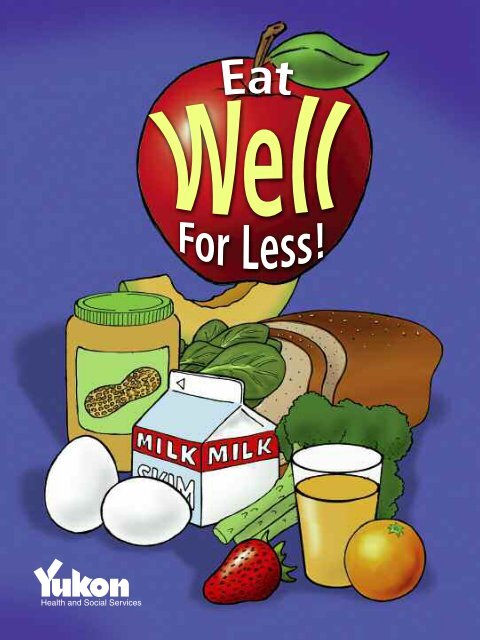

![Women and Alcohol: A women's health resource [2326.26 KB ]](https://img.yumpu.com/22340649/1/190x245/women-and-alcohol-a-womens-health-resource-232626-kb-.jpg?quality=85)
